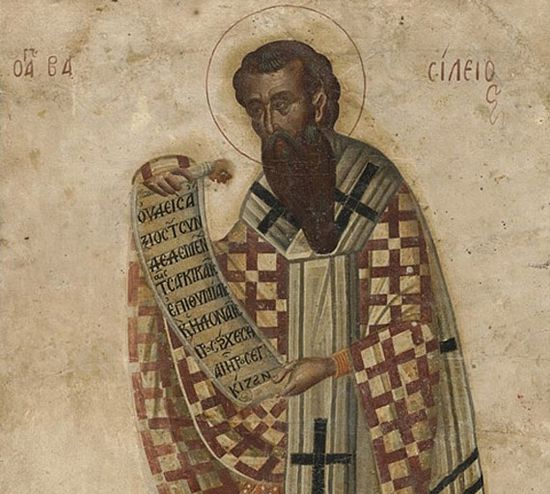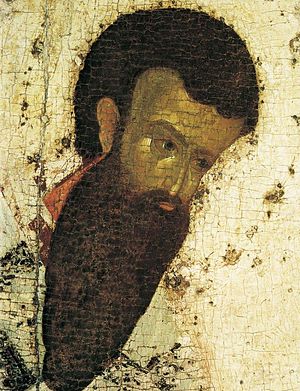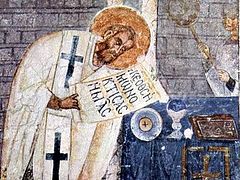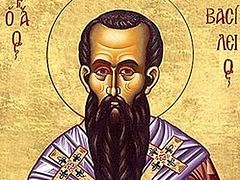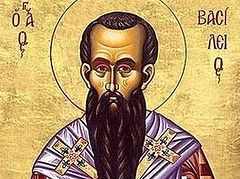Hierarch Basil the Great is one of the Church’s most remarkable theologians. His influence on the fortunes of the Church spread far beyond the borders of his homeland and is still felt in our days. To the pen of St. Basil the Great belong commentaries on Sacred Scripture, a treatise on the Holy Spirit, epistles, sermons and rules for monastic life. He did much for the establishment of the order of the Liturgy, and wrote numerous prayers. The Church reveres him as a fighter for the purity of the faith, a great hierarch and theologian, calling him a “universal teacher.” Only on two other saints—John Chrysostom and Gregory the Theologian—is such a great honor bestowed. Basil the Great was a man of encyclopedic cast. A philosopher, philologist, orator, jurist, scientist and archaeologist, he possessed profound knowledge in astronomy, mathematics and medicine. “He was a ship, loaded with as much erudition as human nature can contain,” writes his contemporary, St. Amphilochius, Bishop of Iconium (Konya, Turkey). Hierarch Basil the Great was born about the year 329 in Asia Minor, in the city of Caesarea (Kayseri), the administrative center of Cappadocia. He was born into a rich and notable family, which had given not a few righteous to be numbered among the choir of saints. Basil’s mother, Emmelia, was the daughter of a martyr who had suffered at the time of Diocletian’s persecutions, while the grandfather on his father’s side had hid in the thick forests of Pontus with his whole family during the course of seven years.
Basil the Great’s parents had ten children: five sons (one died in early childhood) and five daughters. Of them, five were subsequently numbered among the choir of saints: Basil himself, Macrina, Gregory, subsequently bishop of Nyssa, Peter, at first a simple ascetic and afterwards bishop of Sebaste, and the righteous Theosobeia, a deaconess. The future hierarch received a primary education in the midst of the pious and ascetically inclined women of his family. His father himself, Basil the Elder—a lawyer and teacher of rhetoric—was engaged in his education. He received a secondary education from the best teachers in Caesarea of Cappadocia, and later transferred to the schools of Constantinople, where he listened to prominent orators and philosophers. For the completion of his education, St. Basil set off for Athens—the center of classical enlightenment. Here he passed four years, studying, in particular, the philosophy of Plato, which exerted a certain influence on his worldview and theological constructs. In Athens began a close friendship between Basil the Great and Gregory the Theologian. According to the words of the latter, they became everything for each other: comrades and tablecompanions and kindred. “Having one aim,” said Gregory the Theologian, “we constantly grew in our love for one another...Only two roads were known to us: one—to our sacred churches and to the teachers there; the other—to our instructors in the external sciences.” Already in Athens, the friends gave their word to each other to enter the life of the Christian ascetics together. St. Gregory the Theologian remarks that, upon returning to his homeland, Basil the Great was not distinguished by a height of Christian inclination. However, under the influence of his energetic sister Macrina, he quickly overcame the temptations of youth and resolved to dedicate himself to the contemplative life.
In the year 355, Basil the Great was baptized and undertook a journey to the Christian Near East two years later, to the great Orthodox ascetics. The renowned ascetics struck him so much that, upon returning home to Cappadocia, he resolved to emulate them. Having distributed the greater part of his property to the poor, St. Basil led a group of those seeking the monastic life to a picturesque locale on the banks of the Iris River and began to call his friend, Gregory the Theologian, there. However, responsibilities with regard to his aged parents hindered Gregory from realizing his youthful dream of joint asceticism with his friend. All the same, at times he would visit Basil the Great’s monastic community, where the friends would struggle in conditions of scarcity and in strict abstinence. Sts. Basil and Gregory were intensely occupied with the study of Sacred Scripture under the direction of the ancient commentators, in particular, Origen, from whose works they compiled the collection, “Philokalia” (which has nothing in common with the present-day ascetical anthology bearing the same name). At that time, at the request of the monks, Basil the Great wrote a collection of rules for moral life.
By his example and sermons, Hierarch Basil the Great promoted the spiritual perfecting of the Christians of his homeland, where many sought him out. Men’s and women’s monasteries were formed, in which Basil the Great introduced a mixed form of the monastic life—coenobitic and eremitic—free from extremes. Prayer and contemplation in his monasteries alternated with physical labor, while only such trades that did not violate the spiritual collectedness and simplicity of the monastic life were allowed. Other distinguishing features and even innovations in the monastic way of life, according to the rule of Basil the Great, were broad charitable activity and the education of children of both sexes.
In the year 360, Basil the Great, still only a reader, was present at a Constantinopolitan council, and in 364 he was ordained a priest in Caesarea. He preached twice a day struggled against the enemies of Orthodoxy. He did much for the inhabitants of his native city during a terrible famine. Upon becoming archbishop, Basil continued to lead a strict ascetic life; he visited the poor, the sick and the leprous, and founded a hospice the size of a small town. St. Gregory the Theologian describes Basil the Great’s appearance thus: a well—proportioned figure with a full, light brown beard, a slow gait, the absence of haste in movements and speech, and inner concentration; everything in him evoked esteem, and even his adversaries would bow before him.
The fourth century, in which Basil the Great’s lived, was a remarkable, golden age of patristic literature and, at the same time, a tragic period in the history of the Church. Heresies appeared, one after another—Arianism, Apollinarianism, Nestorianism, Eutychianism—bringing disturbance and instability into the enclosure of the Church, and undermining her authority and the faith in the hearts of the weak. The most dangerous of the heresies was Arianism. The Arians adhered to the false teaching according to which the Son of God was not eternal, did not exist before birth, was not without beginning and, therefore, was not of one essence with God the Father. St. Basil wrote three books against the Arians.
In the year 370, after the death of Bishop Eusebius of Caesaria, St. Basil was elevated to the Caesarean episcopal cathedra. Fifty bishops in eleven provinces were subordinate to him. Amidst constant danger, St. Basil supported the Orthodox and made steadfast their faith, summoning them to manliness and patience. He wrote numerous letters to Churches, bishops, clergy and private persons. Struggling against the heretics, St. Basil provoked hostility and all possible intrigues from the Arians all his life.
In the year 372, St. Basil came out openly against the teaching of Eustathius of Sebaste; up until that time they had been on friendly terms. He demanded an Orthodox confession of faith from him, and, when the latter refused, broke off liturgical communion with him. In the dispute on the Holy Spirit, St. Basil was supported by Athanasius the Great, but all his attempts to receive spiritual help from Rome proved to be in vain: already the East and the West did not understand each other on the question of the Holy Spirit. Although they were still confessing the same teaching, they spoke in different languages and used different terms.
The Emperor Valens , who unsparingly dispatched bishops displeasing to him into exile, was a resolute supporter of the Arians. He planted Arianism in other provinces in Asia Minor and came to Cappadocia with the same aim. He sent the Prefect Modestus to Basil in order to convince the hierarch to join the Arians. Modestus threatened him with ruin, exile, tortures and even death. St. Gregory tells of Basil the Great’s response:
“Thou threatenest me with the confiscation of property, but it means nothing for the man who possesses nothing, unless thou desirest to receive this modest clothing and a few books which make up all my estate. Exile?—but I do not know it, since I am not limited by space. If this ground on which I stand right now does not belong to me, then the whole earth belongs to God, Whose temporary guest I am. Torments?—but they do not have power over one not having flesh, except perhaps for the first blow, which thou art free to make. Death?—but it will be deliverance for me, since it will quickly bring me to God, for Whom I live and to a greater extent have died, and to Whom I hasten to come...Tell the Emperor that neither violence nor persuasion will force me to accept a wrong teaching.” Modestus was struck by these words. Having informed Valens of St. Basil’s inexorableness, the Prefect added: “We are vanquished, O Emperor, by the leader of the Church.” Basil the Great displayed the same steadfastness in the face of the Emperor himself; he made such an impression on the Emperor by his behavior and staunchness, that Valens would not support the Arians who had demanded the banishment of Basil. Hierarch Gregory Nazianzen tells about this as follows:
In the year 375, on the feast of Theophany, the Emperor himself entered the Basilica in which Basil the Great was performing the Divine Service. The Emperor was struck by the harmoniousness of the singing of those praying and by the reverence of the bishop, who, it seemed, did not even notice the Emperor’s arrival. When Valens made his offering, none of the deacons could bring himself to accept it without the permission of the bishop, and the Emperor, who was used to the servility of the court bishops, was so upset that he staggered and would have fallen, had not one of the clerics supported him. The hierarch then gave a sign that the Emperor’s offering be accepted. By steadfastness, tact, personal charm and sensible tractability, Basil the Great triumphed over his adversaries. Valens tore up the decree that had already been signed concerning the exile of Basil the Great and, departing from Caesarea, left him rich donations for works of philanthropy.
St. Basil performed the Divine Service almost daily. He cared especially about the strict fulfillment of the Church’s canons, watching attentively so that only the worthy entered the clergy. He would frequently go about his churches, taking care that ecclesiastical discipline not be violated anywhere and every partiality eliminated.
St. Basil the Great was an indefatigable preacher of the revival of social justice in the society of his times. The hierarch gave a firm organization to Church philanthropy, being an opponent of private philanthropy and the imprudent pity that is ready to help every beggar indiscriminately. His appeal for the founding of monastic communities was simultaneously an appeal to the feeling of men’s mutual, brotherly responsibility. Man, according to his teaching, can realize the will of God for himself only in the event that he does not separate his fate from the fate of other men. Monasticism, as Basil the Great thought, is the way for the elect. But the very ideals of monasticism communicate to all Christians the ideals the Gospels set down as the basis of each man’s life. Every indifference to the fate of other men, and every kind of individualism, according to Basil the Great, was not only profoundly depraved, but also self-destructive in its nature. He used all of his personal means and all the revenues of his church for the benefit of the poor. In each district of his expansive metropolia, the hierarch founded almshouses. In Caesarea he founded an inn and a hospice, which by their scale seemed to be an entire little town. He was especially concerned about a more just allocation of taxes between lands, and about freeing the clergy, monasteries and almshouses from taxes.
St. Basil prepared the convocation of the Second Ecumenical Council, but did not live to see it. He died from exhaustion on the January 1, 379, at the age of 49. Not long before his death, he blessed St. Gregory the Theologian to accept the Constantinopolitan cathedra.
The Church began to celebrate the memory of St. Basil the Great almost immediately after his death. In a homily on his death, St. Amphilochius, the Bishop of Iconium, said: “Not without reason and not by accident was the Divine Basil released from the body and transported from earth to God on the day of the Circumcision of Jesus, which is celebrated between the days of the Nativity and Baptism of Christ. Therefore, this most blessed one, in preaching and praising the Nativity and Baptism of Christ, extolled the spiritual circumcision, and himself, having put off the body, was deemed worthy of ascending to Christ precisely on the sacred day of the commemoration of Christ’s Circumcision. For this cause it has been enacted to honor the memory of Basil the Great annually on this present day, with celebration and solemnity.”
Troparion, Tone 1:
Thy fame has gone forth into all the earth,/ which has received thy word./ Thereby thou hast taught the Faith; thou hast revealed the nature of created things;/ thou hast made a royal priesthood of the ordered life of men./ Righteous Father Basil, intercede with Christ our God/ that our souls may be saved.
Kontakion, Tone 4:
Thou wast an unshaken foundation of the Church/ and didst give to all mortals an inviolate lordship/ which thou didst seal with thy doctrine,/ O righteous Basil, / revealer of the mysteries of heaven.

